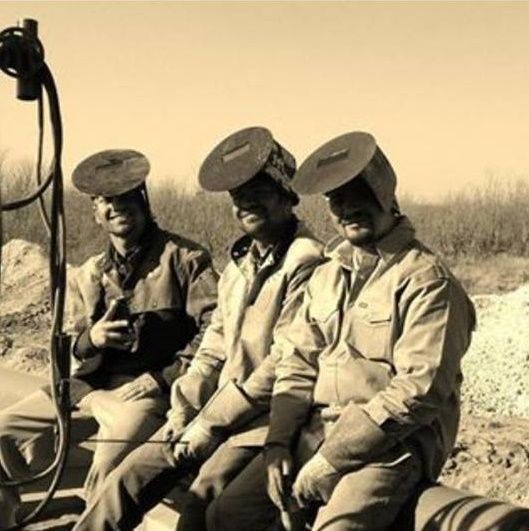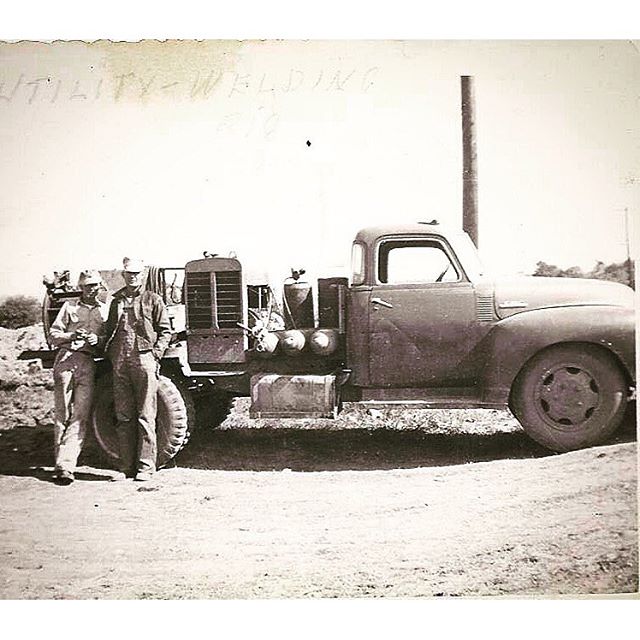Welding transformed the oil and gas industry. Electric arc welding and oxy-acetylene have been tools for shaping a world.
by Bobby Weaver
Welding is one of those trades necessary for the operation of today’s petroleum industry. It is hard to imagine almost any type of oilfield equipment that does not involve welding in one way or another, either in its fabrication or its repair. Although the ability to weld metal dates back thousands of years, it was not developed for large-scale commercial use until the early 20th Century and not commonly used in the oil patch until the late 1920s and early 1930s. Before that, in those earliest days of the Texas petroleum industry, the joining together of metal materials was accomplished through the use of various mechanical fasteners, including riveting, bolting, or strapping techniques.
For example, when the discovery of oil in Texas in the first days of the 20th Century brought the need for large metal storage vessels to the state, two 37,000-barrel riveted tanks were built in Southeast Texas. Those vessels were constructed of metal plates fastened together by rivets. The plates had holes punched on 2-inch centers near their edges. During construction the sheets were overlapped, the holes aligned, and temporarily fastened together by bolts placed in alternating holes. During the riveting process as each rivet was completed the next bolt in line was removed and another rivet started. That process kept the steel aligned and the sheets tight against one another until the rivets were driven in tightly.
The actual riveting process required a four-man crew. The rivets were a bolt-like device with a rounded head and a smooth shaft. One member of the crew heated the rivets to a red hot stage in a portable forge and with a pair of tongs tossed them to the “placer” who caught the rivet in a bucket. The placer then placed the hot rivet in its hole in the metal sheet. At that point a worker called a “bucker” held a small concave anvil over the head of the rivet. Then the “riveter,” using a concave headed hammer, beat the shaft of the rivet into a rounded head similar in shape to the one being bucked until the rivet pulled the two metal sheets tightly together. Finally the placer removed the next alignment bolt and the process was repeated. That was the technique used to rivet metal vessels and structural steel until the 1920s, when pneumatic riveting hammers replaced the traditional hand-held hammers. Even using the pneumatic hammer, with the bucker and the riveter trading off positions every few rivets, the work was a slow, backbreaking, and labor-intensive job.
Once the vessels were riveted together they were caulked to assure that they would not leak. The caulkers used a chisel like device with a slightly bent cutting edge. The caulking device was inserted between the overlapping edges of the steel and driven in until it created a protruding strip of metal. Then the tool was reversed and driven in again, causing the protruding strip to be forced against the opposite sheet of metal, creating a tight fit almost like a weld. At that point the vessel was supposed to be leak proof.
All oil storage vessels greater than those in the 10,000-barrel range were of riveted construction until the 1930s, when electric arc welding became common. After that riveted tank construction in the oil patch began to disappear until by the 1950s they were a thing of the past. However, a host of those vessels are still in service across the nation today as a testament to the longevity of their solid construction.
Smaller field tanks in the 100-to-10,000-barrel range were never riveted. In the very earliest days they were of wooden construction, with the staves held together with metal bands. Within ten years of those first oil discoveries, steel-bolted tanks began to replace wood and they continued to be used almost exclusively until the late 1950s. In the mid-1950s, welded field tanks up to about the 1,000-barrel size began to be constructed in fabrication plants and transported to the field by trucks. By the 1970s, bolted tanks were almost obsolete as the more efficient and longer-lived welded tanks began to replace them.
The pipelining trade experienced a similar evolution from mechanical to welding much like that of the tank building trade. Large-diameter pipelines extending for hundreds of miles are the safest and most inexpensive means of transporting petroleum products. Thus, pipelining was a colorful process utilizing hundreds of workers on each job in those earliest days of the industry, when threaded pipe was the only material available. The last major threaded-type pipeline constructed was in 1927, when the Gulf Oil Corporation laid a 546-mile combination eight- and ten-inch line from Crane in the Permian Basin to Lufkin in Southeast Texas.
Before the Crane-to-Lufkin job was even completed, welding was making inroads into oil patch pipelines in the form of oxy-acetylene welding to join the pipe together. In 1925, the Magnolia Gas Company completed its first major pipeline using that technique. The job was a combination 14-, 16-, and 18-inch pipeline that ran 217 miles from Northeast Texas to Beaumont on the Gulf Coast. Welding soon proved itself an important improvement in the gas pipeline industry, where utilizing traditional threaded pipe had allowed major leakage and pressure control problems. Over the next several years large numbers of oxy-acetylene welded pipelines were laid, especially in the Texas Panhandle. By the early 1930s, that welding process gave way to the newly improved shielded electric arc welding. Arc welding was to remain the mainstay of the industry for the remainder of the century until the present time.
Thus, during the first half of the 20th Century, evolving welding technology, as exemplified by the examples of the tank building and pipelining trades, made major changes in the way things were done in the oil patch. Just how and where this unique way of binding metal objects together arose is a fascinating story. The truth of the matter is that it actually has a very ancient beginning, one whose story has also evolved with time.
The first recorded welding process, known as forge welding, dates from the Bronze and Iron Ages in Europe. It is a blacksmithing technique that involves heating two metals and hammering them together in a process that is repeated over and over until they merge as one cohesive metal. Until the end of the 1800s that was the only practical welding process available, although numerous experimental projects utilizing electricity and a variety of gases were underway.
In 1903 two French engineers developed a suitable torch that utilized both oxygen and acetylene to be mixed and used to heat concentrated areas of metal so that the metal could be either cut or welded. For the cutting process the concentrated flame heats the metal until it becomes molten and with an extra blast of oxygen oxidizes the molten metal to cause it to evaporate, thereby cutting the metal. The same torch is used to join or weld two metals. In that process the metals to be welded are butted up against each other and heated. When the metals became molten a filler metal is inserted so that the gap is filled, causing the metals to become fused or welded into a single entity. This oxy-acetylene method of welding was to remain the mainstay of welding in the oil patch until the 1930s and remains the primary method of cutting steel in today’s oilfield.
The welding process most familiar to today’s oilfield workers is a manual arc welding process known as shielded metal arc welding or simply arc welding or sometimes even stick welding. It utilizes either a direct or alternating electrical current to form an electrical arc between an electrode and the metals to be joined. The principle behind of the process, like that of the oxyacetylene process, was fairly well known throughout most of the 19th Century, but developing a practical way of implementing it did not come about until the beginning of the 20th Century. And it was to be another 20 or 30 years before a practical portable method of utilizing it in the field developed.
In the arc welding process when the electrode touches the metals to be joined they melt and fuse to create a molten weld puddle which when it cools is the weld joint. In the earliest years of this practice it was discovered that atmospheric gases contaminated the puddle, causing a brittle joint. That problem was eliminated by developing a flux that protected the puddle from contamination. Eventually an electrode, generally called a welding rod, was developed with a flux coating that protected the weld puddle to solve that problem. Once the weld cools, the oxidized flux remains as a slag coating, which has to be chipped away before the welding process is complete. It was not until 1927 that an inexpensive method of coating the electrodes (welding rods) was developed, allowing for the process to be utilized in the field.
Another problem associated with arc welding in the field was the lack of an electrical generator portable enough and with enough power to operate efficiently in the field. That problem was also solved late in the 1920s, so that a relatively inexpensive welding process appeared that achieved a higher quality and more efficient way of welding. Since then there have been numerous improvements in the equipment and processes of welding in the oil patch, although the basic equipment has remained the same
So the next time you are out on a job and you see a welding rig pass by with its oxygen and acetylene bottles strapped to the headache and that ubiquitous welding machine sitting on the bed, don’t take it for granted. Stop for just a minute and give some thought to the magic of how a little gas and some electricity has come to supply the ability to cut and shape metal into just about any configuration you might desire. Then meditate on how difficult it would be to accomplish the same thing with a hammer and a chisel. Makes you appreciate progress, doesn’t it?











